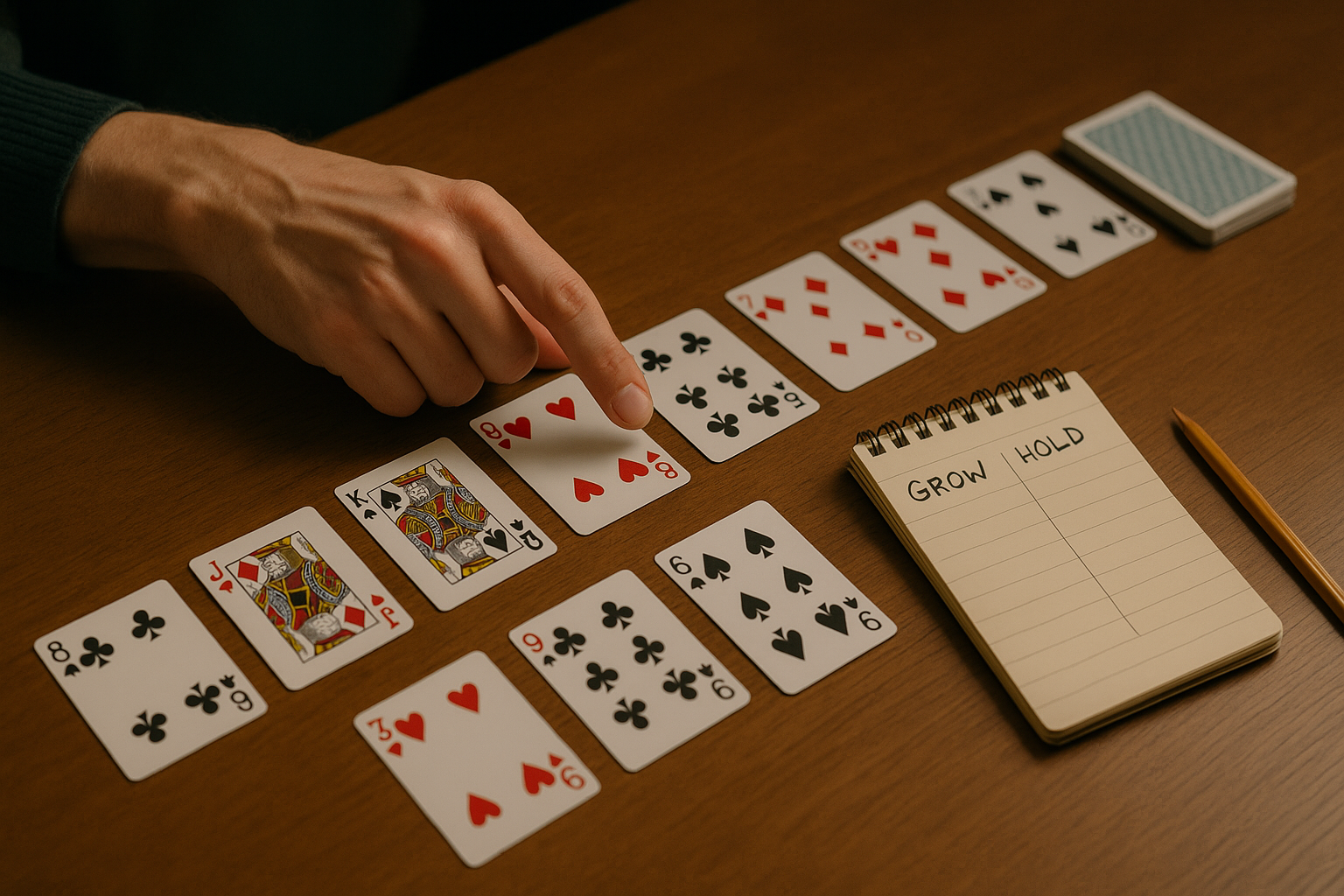Accordion Solitaire Endgame Edges: Pattern Reading & Probability
Picture a narrow endgame: twelve piles left, two promising 3‑left matches, and one tempting 1‑left that would “feel good” now—but might seal the layout shut. The cursor hovers. The board waits. What if one small, measurable rule tipped this from almost‑win to clean collapse?
Here’s the plan: decode the late‑game patterns that matter, apply a lightweight probability lens to each move, run a 5‑minute drill that automates your scan order, and track a few metrics to prove you’re improving. Load a fresh deal on Solitairen and keep it open while you read.
The Late‑Game Lens: What Actually Moves the Needle
When ≤16 piles remain, pure mechanics give way to pattern reading and variance control. Use these four principles:
-
Prioritize 3‑Left Windows Over Immediate Relief
A 1‑left merge that removes a future 3‑left is almost always a leak. Ask: Does this 1‑left keep at least one 3‑left live after compression? If not, pass. -
Protect “Dual‑Trigger” Spots
A dual‑trigger is a pile that will match by rank or suit after one compression. Moves that keep two distinct matches alive dramatically raise your chain odds. -
Advance High‑Leverage Ranks
When several options are neutral, move the pile that brings Aces/Kings/Queens closer to high‑traffic zones; these ranks create more downstream matches in practice. -
Delay “Pretty” Merges That Don’t Increase Options
If a merge doesn’t raise your open‑match count (the number of legal matches visible after the next compression), it’s cosmetic. Count openings, not feelings.
Quick self‑check:
-
Do you scan leftward three piles back before every 1‑left in endgame?
-
Can you name at least one dual‑trigger position on your current board?
-
After each move, do you tally whether your open‑match count went up or down?
-
Do you know your CI trend (average piles remaining when you stop) over the last 30 games?
Probability in Plain Language (no calculator needed)
Think of each visible match as a branch with a rough chance to unlock another branch. In the endgame:
-
3‑left matches have a higher expected branch length because they remove more space and expose new adjacencies.
-
Dual‑triggers compound: preserving two legal futures often doubles your odds that one survives compression.
-
Serial 1‑lefts shrink the tree; two in a row without a new 3‑left is usually a warning sign.
You don’t need exact percentages—just track whether your choices increase the number of future branches.
Step‑by‑Step Micro Drill: “Branch‑Count Play”
Goal: train your eyes to choose moves that grow the future decision tree.
Setup (60 sec)
-
Open Solitairen and start a new game.
-
Set a timer for 4 minutes of play + 1 minute review.
Run (4 min)
-
Before every move, say out loud one of: “Grow” (opens ≥1 new match next), “Hold” (neutral), “Shrink” (kills a likely 3‑left).
-
Only take Shrink if it immediately creates a dual‑trigger elsewhere.
-
If a 1‑left is available, scan three piles back first; take it only if a 3‑left still survives.
Review (1 min)
-
Tally Grow/Hold/Shrink counts.
-
Note every Shrink you took—did it pay off within two moves?
-
Write one micro‑rule for the next session (e.g., “No back‑to‑back Shrinks in endgame”).
Repeat for 5–8 games. This drill reduces autopilot and lifts your chain frequency.
Sabermetrics for the Endgame: Track What You Can Control
Add these to your tracking sheet (keep the earlier metrics from Part 1):
-
Open‑Match Delta (OMΔ): openings after a move minus openings before. Target a positive average in endgame.
-
Dual‑Trigger Preservation (DTP): percentage of turns where you kept at least one dual‑trigger live.
-
No‑Shrink Streak (NSS): longest streak of consecutive Grow/Hold moves without a Shrink.
-
Compression Index (CI): piles remaining when you stop (lower is better).
Synthetic example (format only—replace with your data):
| Session | Games | OMΔ (avg) | DTP % | NSS (avg) | CI (avg) |
|---|---|---|---|---|---|
| Week A | 10 | +0.21 | 58% | 3.4 | 12.6 |
| Week B | 12 | +0.37 | 66% | 4.2 | 11.1 |
| Week C | 12 | +0.41 | 71% | 4.8 | 10.3 |
Reading it: as OMΔ rises and DTP improves, CI falls—exactly what we want.
Transparent Methodology & Research Workflow
Data hygiene
-
Stick to standard Accordion rules for a whole week.
-
Log every game; avoid cherry‑picking.
-
Mark endgame start at ≤16 piles for consistent comparisons.
Analysis rhythm
-
Review after each 10–12 game session.
-
Change one behavior per week (e.g., “protect one dual‑trigger at all times”).
-
Use a 5–7 game moving average for CI and OMΔ to smooth variance.
Tooling
-
A simple two‑column note (“Move → Grow/Hold/Shrink”) beside your board is enough.
-
If you like to play solitaire online free without setup friction, keep Solitairen pinned and log results right after each game.
Practical Endgame Patterns (with quick rules)
-
The Ladder: alternate suit/rank matches every 2–3 piles; one merge triggers a cascade.
-
The Pocket: leave a safe 1‑left you can cash later to re‑open a 3‑left if the tree stalls.
-
The Bridge: take a short‑term Hold that positions a high‑leverage rank two piles closer to a dual‑trigger.
Summary & Next Step
Endgames reward calm pattern reading more than raw speed. When you preserve 3‑left windows, guard dual‑triggers, and choose moves that grow the tree, Accordion’s “close but stuck” finishes turn into controlled collapses. Track OMΔ, DTP, and CI for the next 30 games and watch the curve bend.
Call to action: Open Solitairen, run the Branch‑Count drill, and commit to one rule for the week (for example: “No 1‑left unless a 3‑left still survives”). What’s your CI after three sessions—and which micro‑rule moved it most?
